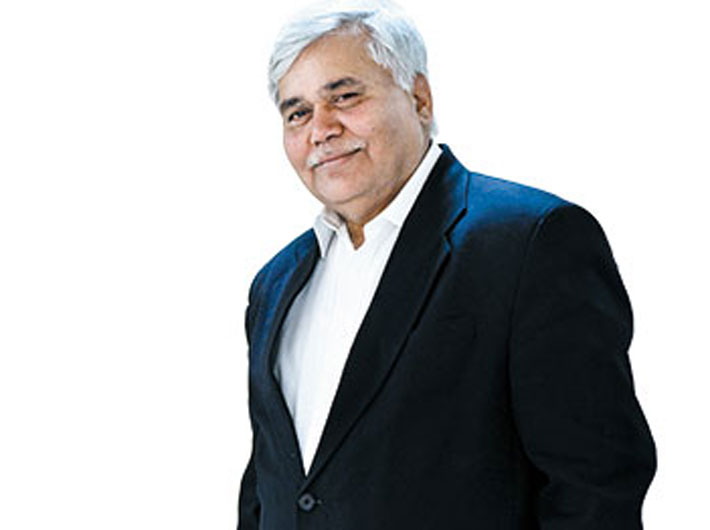Ram Sewak Sharma, Secretary, Department of electronics and information technology
In a freewheeling interview with Pragya Gupta, the new secretary of department of electronics and information technology (DeitY) says that a decentralised approach to e-governance will work better in a country like India. The 1978-batch Jharkhand cadre IAS officer (who earlier was DG of UIDAI) also wants to increase the pace of backend digitisation and believes that data has to flow in real time in order to be effective and efficient.
What are your priorities as the secretary of DeitY?
We are going to have a new government at the centre and priorities will have to be decided by them. Our job is to implement the policies and priorities of the government. Having said that, accelerating the pace of implementation of e-governance projects, both at the central and state levels, redesigning and upgrading some of the ongoing projects with a view to leverage latest technologies and form-factors (cloud, mobiles, web-technologies), introduction of e-governance in new areas, especially those relating to citizen service deliveries, will be some of our priorities in e-governance space. Promoting domestic electronics manufacturing is another important area of focus. We already have a clear policy framework to accelerate its implementation. Some of these works will also require restructuring and strengthening of NIC and other organisations of DeitY.
India still follows the silo approach and does not have plans for integrated governance. Will improving that be part of your agenda?
Technologies have undergone a substantial change since NeGP was launched in 2006 and e-governance projects will have to be upgraded and redesigned to take advantage of the latest technology. Yes, there are silos between departments and also many silos in the same department. There are many reasons for silos and it may be difficult to integrate all these systems in a short time. However, developing and implementing robust protocols for information interchange, and development of new applications and platforms will bring about desired integration. A number of platforms have already been developed. Aadhaar, payment gateways and SMS gateways are some examples. We will continue to work to develop and deploy applications as platforms in future so as to bring about real integrated governance using common and reusable infrastructure.
Unlike the US and many other countries, India does not have a comprehensive e-governance law. Would you like to drive e-governance differently?
A number of service delivery areas come within the domain of the state governments. Many states have enacted the electronic services delivery legislation and even legislation relating to time-bound delivery of the services. I think helping and guiding the states in accelerating their e-governance efforts will continue to be an important strategy tool. While the legislative framework is certainly important, I do not think that non-existence of a national legislative framework is in any way a constraint to accelerate and implementation of e-governance.
While a majority of e-gov projects in India are citizen-centric, not much has happened at the back-end. How do you plan to address this?
I agree with you that projects like common services centres (CSCs), Gram Sewa Kendras, Mee-Sewa have automated many services. Various states are at different stages in this area. However, it is also true that many of the services that are being delivered through these points still use manual methods at the back-end. As an example, while we deliver caste and income certificates through these service points, we follow the same manual process of enquiry at the back-end.
We need to change these manual internal processes to make the entire service delivery chain more robust. A lot of good work has been done in many states in this area. We need to replicate the best practices and efforts quickly in the remaining states. Automation of the back-end processes will require substantial process re-engineering and change of the attitudes of the departments. To achieve some of this, we have a number of projects like e-District and e-Office. However, we still need to travel a long way in the area of changing the back-end processes so as to make them time-bound, transparent and cost effective.
One of the impediments, which I have felt in automating the back-end processes, is lack of trust in the citizens. There are lots of areas where self-declaration should be sufficient and there are provisions where action can be taken against the person for providing wrong information. We, however, in the government seem to be comfortable only with affidavits and other verification mechanisms that are time-consuming and put a cost burden on citizens and are archaic. Most importantly, they do not improve the quality of information.
What are the basic changes you wish to bring in the e-governance plan?
NeGP has to leverage the best technology in terms of storage, transmission and last-mile delivery of information. We must use cloud, fibre and the mobile. Most importantly, we have to ensure that the processes are fully aligned with the automated systems and there are no offline data entries. Data should be a by-product of events and everything should be real-time and online. There is no scope for offline data entry and end-of the day reconciliations. Wherever required, we must use the crowd-sourcing methods to get the data collected (online filing of applications). We also will have to ensure that we provide transactional capabilities on the mobile, which is now widespread across the country.
E-governance in India has so far been primarily driven by the centre. How comfortable are you with the model that includes part-funding by the union government?
Honestly, I do not see anything wrong in the current model of part-financing of e-gov efforts of the states. I also do not see anything wrong so long as the central government helps states in providing a platform for sharing their best practices and also helping in replicating best practices. However, the model where the central government provides the application and everybody has to use it has not worked so successfully and will not work –
especially when there are no SLAs
between the user states and the development agency (typically NIC). In my view, the central government (through professional agencies) should develop platform applications (software and application as service) and the states can have a choice of joining this platform or continue to have their own applications. This application development should also be done by an entity which should be bound by SLAs with the participating states.
A few candid examples of such platform are PDS, transport, courts, registration and any other areas where the variation in the business rules among states is configurable. Fortunately, today’s technology is capable of fully supporting such models. This can create a vibrant environment where we will be able to deploy many critical applications for the states and make them run in a very short time.
Do you think your experience as the chief secretary of a state (Jharkhand) will help you better handle the centre-state matters?
Definitely. I must tell you that the most acute problem in the states is the lack of capacity both in terms of re-engineering the processes, software and systems development and handling the change management. The capacity building component of NeGP will have to be redesigned and strengthened so that it is more helpful to the states.
In India only 1.1 per 100 residents have access to fixed broadband, as against the world average of 9.9 per 100 inhabitants. What ails India?
Yes, the situation is far from satisfactory. There are a number of programmes which have been undertaken in recent years that seek to improve the connectivity in the country and provide a high bandwidth in the villages. We will have to accelerate the implementation of projects like NOFN. There is large amount of fibre already laid in our country. We need to create an ecosystem where sharing of this infrastructure becomes a win-win for all the stakeholders. This fibre grid can provide the desired connectivity. From whatever I have seen as chief secretary in Jharkhand, implementation of this is very slow. We will need to accelerate this.
How do you plan to boost indigenous manufacturing of electronics hardware?
The need to promote electronics sector is not a matter of choice. Both for economic reasons as well as for strategic reasons, we need to have a vibrant electronics design and manufacturing industry that is globally competitive. To promote the electronics hardware sector, a comprehensive national policy on electronics was approved about a year and half ago. Incentives have been announced under the modified special incentive scheme and under the electronic manufacturing clusters (EMCs) scheme. Two semiconductor wafer fabrication facilities involving investment of over '60,000 crore have been approved. Fresh investment proposals amounting to nearly '14,000 crore have been received. In-principle approval has been granted to seven new greenfield EMCs involving investments of nearly '2,000 crore.
It is also important to note that a scheme with an outlay of nearly '100 crore has been approved in January 2014 for providing industry-required vocational training to 90,000 persons in electronics. Another scheme was approved in March 2014 which provides for increasing the number of PhDs in electronics manifold. This scheme provides nearly '200 crore for creating 3,000 new PhDs in the sector over the next five years or so. Besides, Compulsory Registration Order, mandating safety standards for 15 electronic products, has been implemented from January 2014. This will curb the inflow of sub-standard electronic products and provide market for domestic manufacturers.
What are these issues?
While the industry has been highlighting it for long, I would like to assure that we are making effort to address issues like the inverted duty structures. Then we have issues related to creating funds for promoting innovations, the challenge of creating an eco-system of research in large area electronics and a network of incubators to promote start-ups in the sector. There is also a need to review existing incentives policies. This will help enhance their scope, remove shortcomings and make it easier for the industry to take advantage of the incentives provided in the policy. I am also aware of the need of new institutional frameworks like the national electronics commission/mission so as to make decision making agile and responsive. A new policy to specifically support the fabless industry is also needed. The intentions are clear and I am quite hopeful that with all these efforts, subject to their proper and speedy implementation, you will see a huge surge in domestic electronics manufacturing in India.

